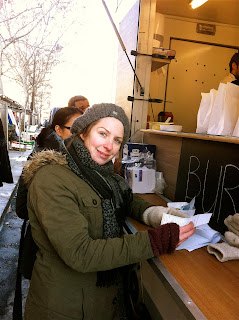Chances are that any time you've visited a stately home, a chateau or a museum, and have admired a tapestry such as this one designed by François Dubois, which hung in the Tuileries Palace, it was made here, in the Ateliers de la Manufacture des Gobelins.
Originally founded as a dye works in the mid-15th century by a family named Gobelin, the business flourished, growing into a successful textile factory. It did not escape the eagle eye of Louis XIV, who, in 1662, had his man Colbert step in and buy the business, creating a royal tapestry works as well as a furniture workshop. It has remained under "national" patronage ever since.
Colbert brought in the royal painter, Charles le Brun to oversee the design and manufacture of tapestries and furnishings, chiefly for royal palaces, residences and state buildings. Using both high and low warp looms, the workshops employed over 250 artisans, who lived with their families within the Gobelins "compound". Many of these buildings survive today, including Le Brun's own residence.
For almost thirty years, under le Brun, the Gobelins factory produced an astonishing array of exquisite tapestries, upholstery and furniture in a richly ornate style. This one, attributed to a design by le Brun himself, honored a visit by the King (on the upper left, in red), Colbert, and the King's younger brother Philippe, to the factory, with the workers scurrying around to present their latest works. Given the detail and complex patterns of color, a worker could spend many years working on one tapestry. The King himself would have been considerably older by the time this one was finished! This is still true today. During our tour of the atelier buildings, we met a weaver -- a man in his early 30s -- who is currently working on a piece from an 18th century design. Our guide told us that it would take him ten years to complete it!!
Apart from a brief closure at the end of the 17th century and a similar interruption during the French Revolution, the Gobelins factory has continued to produce tapestries of the highest standards all the way to the present time. The Savonnerie Carpet Factory was incorporated into the business in the mid 19th century.
Today, the ateliers fall under the auspices of the French Ministry of Culture, who, just like le Brun and those who followed him, still seek and train artisans to make new tapestries and carpets, as well as restore old ones. Making sure this great French tradition doesn't die out. Our tour took us into the Savonnerie carpet atelier, where I managed to snap this one illegal photo, before being chastised by our guide! As you see, she is raising her hand, "mais non, Madame, pas de photos!" (I excused myself meekly.)
Today's weavers are recruited from as early as high school, even sometimes before graduation, to begin their training. No formal art school is required, just a passion for colors and the materials. Here this team of mostly young women is working on an enormous carpet of a seascape pattern, designed by a contemporary French artist. Working on the right side of the high warp loom, the workers periodically separate the strings and peer intently through to the back, where mirrors display the reverse side. Again, this project will take some years to complete, even with a team such as this.
We asked about working conditions, thinking that repetitive stress syndrome must be a problem. And it is. Breaks are frequent and workers are not required to be there every day. They might work two out of five days. In these days of "worker protections", the unions keep a close eye on everything!
Our tour guide described the world of weaving in great detail, giving us much new vocabulary to ponder in French and, occasionally, English -- "heddle" anyone?! Our heads were spinning, but before leaving, we wanted to see the galleries in the main front building. Here, temporary exhibitions rotate through the halls. Currently, a group of 31 contemporary artists have created a series of installations, combining old, traditional tapestries and furnishings with their own innovations.
Stepping inside the structure, we found ourselves standing on a mirrored floor, looking out through glass and mirrors at the tapestries, seen through seemingly random sets of words and phrases printed on the mirrored glass walls.
It made for a dazzling and dizzying world of light and color. We tried to decode the theme, but all we could come up with was that it must have something to do with the eternal French question about "the meaning of life"... or, perhaps, the meaning of "heddle"!
À bientôt!



















































